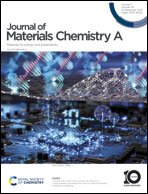Presenting the shape of sound through a dual-mode strain/tactile sensor†
Abstract
Next-generation wearable electronics yearn for sensitive components with cost-effectiveness, flexibility, sensitivity, and multi-functionality. In this work, an ultra-stretchable dual-mode strain/tactile sensor with high sensitivity and a wide detection range is developed on a permeable olefin block copolymer (OBC) nonwoven substrate, which manifests outstanding capabilities for monitoring human motions and presenting the shape of various sounds. A skin-friendly OBC elastomer is first electrospun into a highly elastic fibrous matrix; CNTs are subsequently incorporated in the OBC microfibers firmly and homogeneously via a versatile sonication-assisted assembly, achieving a highly elastic fibrous conductor with superior piezoresistive sensing performance under both stretching and pressing. Specifically, an extremely low detection limit (0.074%), an ultrawide sensing range (0.074–350%), and a fast response time (107 ms) are obtained when the fibrous conductor is utilized as a strain sensor. Moreover, a wide response range (0–70 kPa), a high sensitivity (0.073 kPa−1), and fast response/recovery times (30 ms/60 ms) are also achieved when it is applied as a tactile sensor. Thus, the dual-mode strain/tactile sensor is capable of monitoring a wide range of human activities ranging from subtle deformations to vigorous body movements. More excitingly, a wireless sound detector developed based on the dual-mode sensor can readily differentiate a range of natural sounds through air pressure sensing, exhibiting enormous potential in sound visualization technology.



 Please wait while we load your content...
Please wait while we load your content...